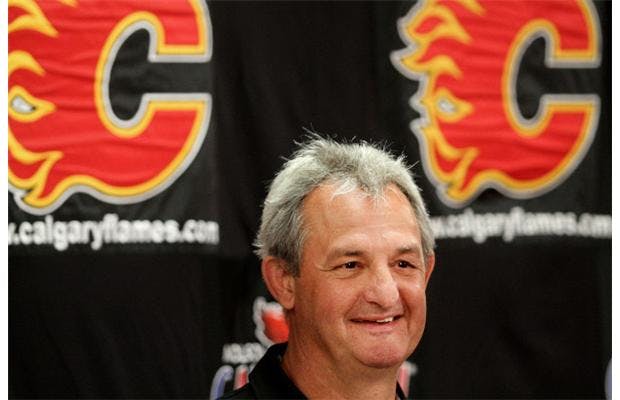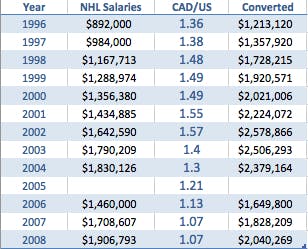The Rise and Fall of Darryl Sutter – Part 2: Sutter’s Fortune
By Kent Wilson
13 years ago
Students of history will tell you that great men aren’t merely self-made icons who singlehandedly clawed their way to power and influence through force of will alone. Martin Luther’s reformation grew out of the Renaissance and the corruption of the church. The Weimer Republic was constructed in the rubble of World War I and it gave rise to Adolph Hitler. Numerous, interdependent factors always precede and instruct revolution.
Those are rather grand analogues to a hockey team and it’s return to respectability, but the principles are the same. In as much as Darryl Sutter was a causal agent in the Calgary Flames rise from the ashes, he was also a beneficiary of circumstances both internal and external that were outside of his influence. In many ways, Darryl joined the organization right as it was poised to emerge from the dark ages.
The Core
It doesn’t take more than a cursory glance over the Flames 2002-03 roster to see why the club was a bottom feeder. The fifth highest scoring player was Toni Lydman, with 26 points. The team was littered with marginal NHLers such as Petr Buzek, Craig Berube, Scott Nichol, Blake Sloan and Mathias Johansson. Bob Boughner and Dave Lowry were on the tail end of their careers. Rob Niedermayer was counted on as a top-six option. Oleg Saprykin was an unsure sophomore trying to justify his high draft position. Denis Gauthier, a guy whose skill set had one bullet point (he hits!), averaged 20 minutes a night.
It was a bad team, the seventh iteration of similar failures since the Flames starting bleeding marquee talent in the mid-90’s. Gone were former heroes Theoren Fleury, Doug Gilmour, Gary Roberts and Joe Nieuwendyk. In their stead were cheap facsimiles of NHL stars, marginal rookies, doddering veterans and the fruits of seemingly ill-fated trades.
Squint, though, and you’ll spy the foundation upon which Sutter would build his empire. Jarome Iginla was 25 years old, already an Olympic gold medalist and league leading scorer. Robyn Regehr was 22 years old, already a veteran of three seasons and a capable shut-down defender. Craig Conroy (already 32) was in his second season with Calgary, a Selke-nominated center and a steadying influence on Jarome.
Other significant if transient contributors to Darryl’s early success were also members of the 2002-03 squad, including Stephane Yelle, Martin Gelinas, Steve Montador, Chris Clark and Jordan Leopold. Bubbling under the surface were Mike Commodore, Matthew Lombardi and Chuck Kobasew. Chris Drury wouldn’t be part of the 2003-04 cup run, but was converted by Darryl into Rhett Warrener and Steven Reinprecht.
The overall collection of players was lackluster, but the nucleus of the club’s future was there. It was a core of players almost entirely assembled by other men. Iginla, Regehr and Conroy were the fruits of trades (unpopular at the time) that saw Neiuwendyk, Fleury and a Cory Stillman leave town. Drury and Yelle were had for Derek Morris. Jordan Leopold was acquired for a second round draft pick and plug Andrei Nazarov.
Because the Flames had been so bad for so long, the hopes for success were exceptionally dim at the time. The perpetual gloom that hung about the franchise clouded the fact that Darryl’s predecessors actually got a few things right. The new guy essentially stepped over the bodies of the men that fell before him and accepted the burgeoning rewards of their sacrifices.
The Canadian Dollar and the Lock-out
Of course, the various rebuilding efforts of Doug Risebrough, Al Coates and Craig Button weren’t engaged in arbitrarily. There are a number of reasons the Calgary Flames fell from grace in the 90’s, but the financial climates of the league and North America at large were significant contributors. Not only were salaries for players escalating at a heady rate, the imbalance between the Canadian and American dollar was also peaking at near historical levels. The year that Glen Sather signed Bobby Holik to a $9 million/year deal (2002), one American dollar was worth about $1.57 Canadian. The result was doubly harmful for the Flames: not only was the average salary accelerating apace at the behest of the big-market clubs, but the currency exchange meant significantly higher payroll expenses for Canadian teams. Paying your employees in American dollars while collecting your revenues in the native, relatively less valuable currency was obviously a severe handicap.


The above table shows the average NHL salary from 1996-2008, the average annual Canadian-to-American conversion rates as well as the NHL average salary converted to Canadian dollars. The graph shows the NHL salaries in American dollars (blue) and what those costs looked like in Canadian money (green) at the time.
Two things are immediately obvious: NHL salaries increased rapidly year-over-year in the ’90s and the weakness of the Canadian dollar greatly exacerbated the escalation for Canadian franchises. So although average NHL salaries in 2002 ($1.64M) and 2007 ($1.71M) were almost equal, the difference was vast in Canadian terms ($2.58M in 2002 versus $1.83M in 2007) due to the fluctuating rate of conversion.
The disparity peaked pre-lockout in 2002 during Craig Button’s reign. It began to drop in 2003 and has been nominal post-lockout.
The challenges for Button et al. in attracting and retaining talent wasn’t limited to currency issues. In a capless environment, not only were salaries increasing rapidly, but they were mostly flowing to the biggest markets in the league: Toronto, New York, Detroit, Colorado, etc. The Rangers, for example, spent north of $75 million in each season between 2001 and 2003. Colorado and Toronto were in the $60 million range while the Red Wings actually topped everyone with their $77+ juggernaut squad in 2003-04 (a team that featured no less than eight players making $5 million or more).
The Flames, in contrast, were building $30 million teams. Calgary’s rather uninspiring 2002-03 roster noted above cost about $32 million, the 10th cheapest in the league that season. Jarome Iginla, who at 25 had yet to see unrestricted free agency, was the organizations most expensive player at $5.5 million (or $8.63M! Canadian). Roman Turek was the only other guy making more than $3 million a year.
As such, the primary reason the 2002-03 Calgary Flames looked like a random collection of flotsam (outside of a few notable names) is because they were. A combination of rich clubs hoovering up talent and a less than notable draft record left the Flames sifting through bargain bins to fill-out gamesheets. It was David versus Goliath; and the lousy Canadian currency meant the former didn’t even have a slingshot.
Aside from his first year in the big chair (2003-04), Sutter didn’t labor under the same kind of restrictions. The Canadian dollar began to regain it’s value in 2003 and has remained only marginally cheaper than its American counterpart since 2006. The 2004-05 lock-out and resultant salary cap put an end to (or at least a limit on) prolifigate spending, ensuring a greater spread of talent around the league.
None of this analysis is meant to entirely excuse the failures of the pre-Sutter regimes. Mistakes were made that were non-trivial contributors to Calgary’s extended dry spell (Doug Gilmour for Gary Leeman; the draft choices of Trevor Kidd, Rico Fata, Brent Krahn, etc.). However, there’s little question that salary escalation and a weak dollar combined to form an environment inimical to success. The foundational players of the franchise’s high point under Cliff Fletcher aged or were priced beyond Calgary’s budget. Fletcher’s successors struggled fruitlessly to replace them, in no small part because expenses sky-rocketed as the team floundered.
The gap left by the expulsion of star players and the widening gulf between rich and poor/Canadian and American in the NHL was an interminable void for Button et al and they strained for years to close it in vain. And yet, just as various forces conspired to finally suture it shut, Darryl strolled on through and emerged a savior on the other side.
Recent articles from Kent Wilson




